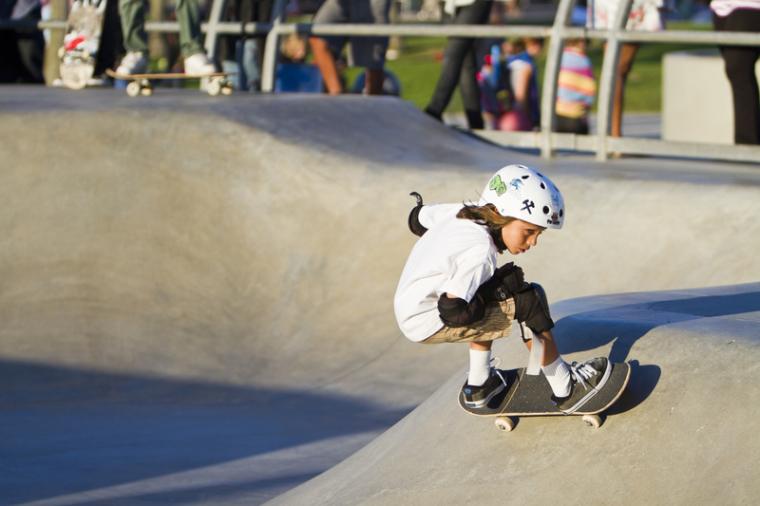

If anecdotal evidence is any indication, the Olympic debut of skateboarding in Tokyo this summer has helped the sport catch new air. Once stigmatized as a fringe activity for kids who skipped school, skateboarding is now building on the momentum of 2020, when school closures led to the rediscovery of this outdoor activity – that packs plenty of mainstream appeal.
“Skateboarding saw a growth in sales like it hadn’t seen in years,” Jeff Kendall, a former professional skater and now president and chief marketing officer of NHS Inc., a skateboard manufacturer and distributor, told NPR.orgearlier this year.
Kendall said the inclusion of skateboarding at the Olympics and its increasing presence on social media platforms such as YouTube, Instagram and TikTok also are responsible for the sport’s rising popularity. Before the pandemic hit, the skateboarding market was projected to reach $2.4 billion by 2025, NPR reports; now it’s likely to go even higher now.
“This is something we’re seeing all around the 80 countries that we sell to in the world,” Kendall said. “I think that by the end of 2021, there’ll be more skateboarders in the world than ever before.”
Jeff Ament — bass player and founding member of Pearl Jam — is a firm believer in introducing skateboarding to as many newcomers as possible. As The New York Timesstates, he’s “seven years into his self-appointed mission to bring high-end skate parks to every city and town in Montana that will have one.” That includes a nearly 13,000-square-foot $300,000 facility in Browning, Mont., called Thunder Park.
“The great thing about skateboarding is you don’t have to belong to a club or pay a fee,” Ament, who lives in Missoula, Mont., told the newspaper, adding that his mission is “much bigger than skateboarding. You are teaching kids to get up when they fall.”
New skate parks are being built in cities all over the country, including Madison, Wis., Morenci, Ariz., and Charleston, W.Va.But skateboarding is not just surging in the United States. Skate shop owners in England report strong business as a result of both the Olympics and the increased emphasis on outdoor activities in the wake of the pandemic.
“The Olympics has without doubt had a positive impact,” Tom Brown, owner of Welcome (the only independent skate shop in Leeds), told The Yorkshire Post. “We’re seeing increasing numbers of young children and family footfall in the shop. We often have dads that used to skate back in the day buying a new set-up for themselves at the same time as buying one for their kid.”
Skate parks in England are seeing an increase in business, too — especially for girls-only sessions. According to Olympics.com, the average age of the women skateboarding medalists at Tokyo’s Summer Games was 15.
The silver-medal success of 13-year-old Brazilian Rayssa Leal at the Olympics has ignited the sport among females in that country, according to global news agency AFP. “There are more and more skateboarding classes for small kids, and I see there are often more girls than boys. That’s what is really awesome about the Olympics,” Dora Varella, a professional skateboarder and a member of Brazil’s Olympic skateboarding team in Tokyo, told AFP, adding that when she started in the sport 10 years ago, she was one of just a few girls.
We Skate, a skate club at the University of Maryland for women, as well as nonbinary, gender non-conforming and LGBTQ+ students, is helping efforts to advance the sport’s demographics with lessons and sessions for groups that have traditionally been left out of the skateboarding scene.
“There [are] so many people that have wanted to skate but never got the chance to try, either because they were too nervous, they felt intimidated by the skate scene, or maybe they just never put themselves out there,” Anna DiRienzo, who started We Skate, told The Diamondback,the University of Maryland’s student newspaper. “When you go to a skatepark, it’s heavily male-dominated, and it doesn’t always feel the most welcoming.”
Indeed, as the newspaper notes, “there were vicious attacks against LGBTQ+ skaters,” in the 1980s and 1990s. In more recent years, according to the National Museum of American History(which has posted about inclusion in skateboarding), the sport “has made great strides in its acceptance of LGBTQ+ skaters.”
“I’m really stoked for this upcoming generation [of skaters],” Latosha Stone, owner of Proper Gnar, which designs and produces skateboards and clothing for girls and young women, told NPR.org. “They’re not going to have to deal with growing up and being … the only [skater] that looks like you out there, you know?”

